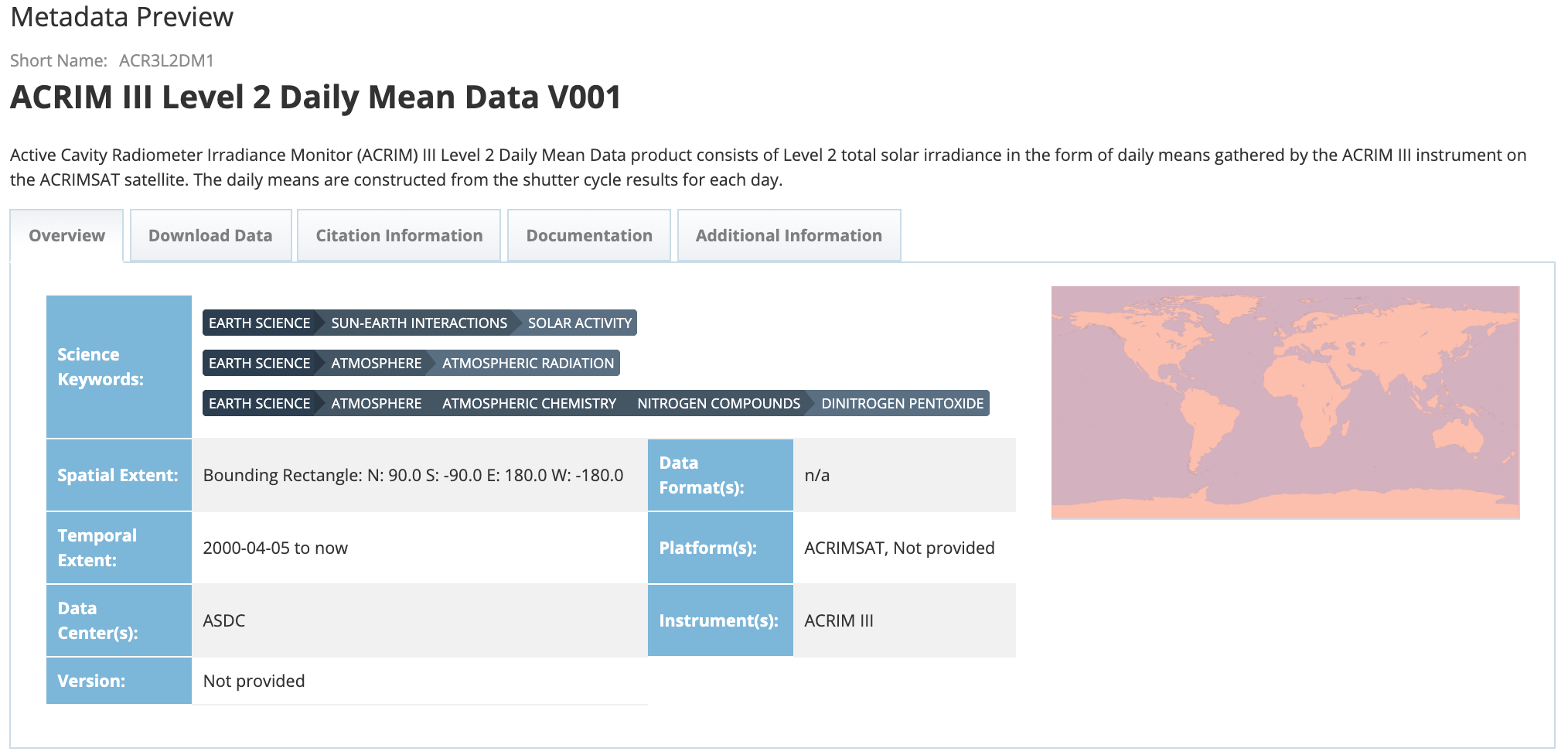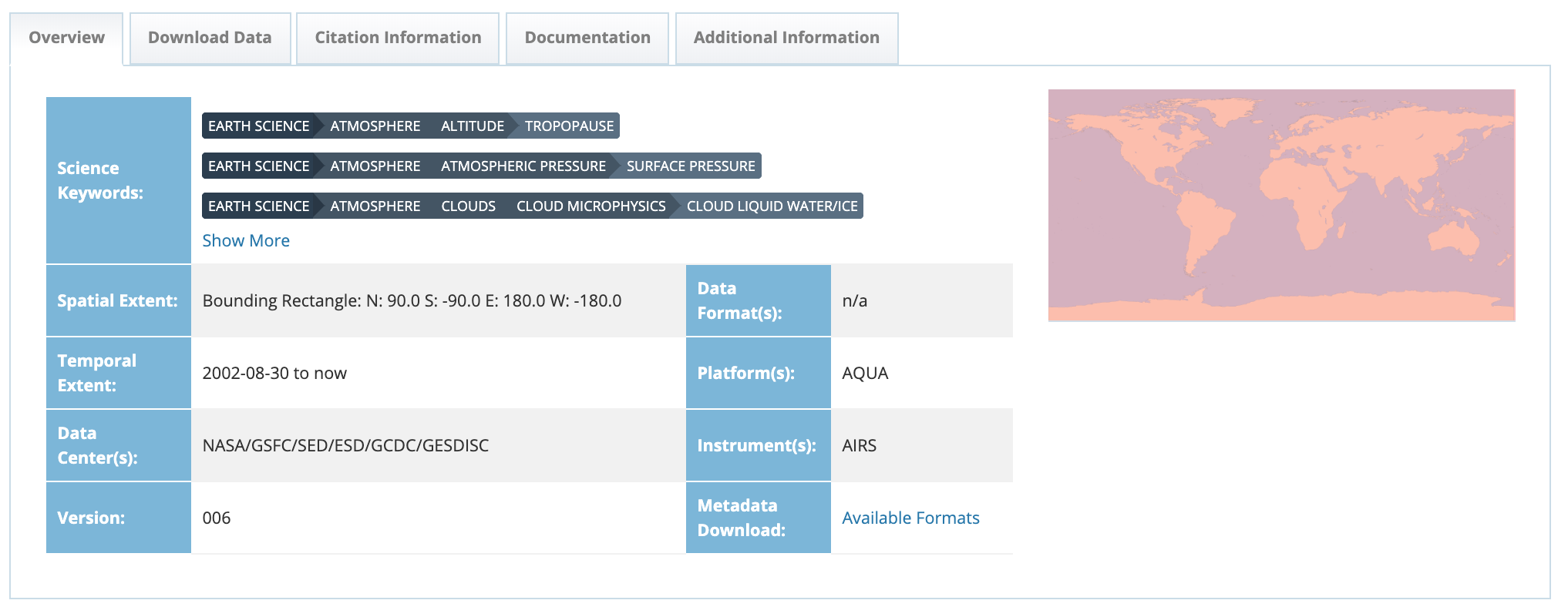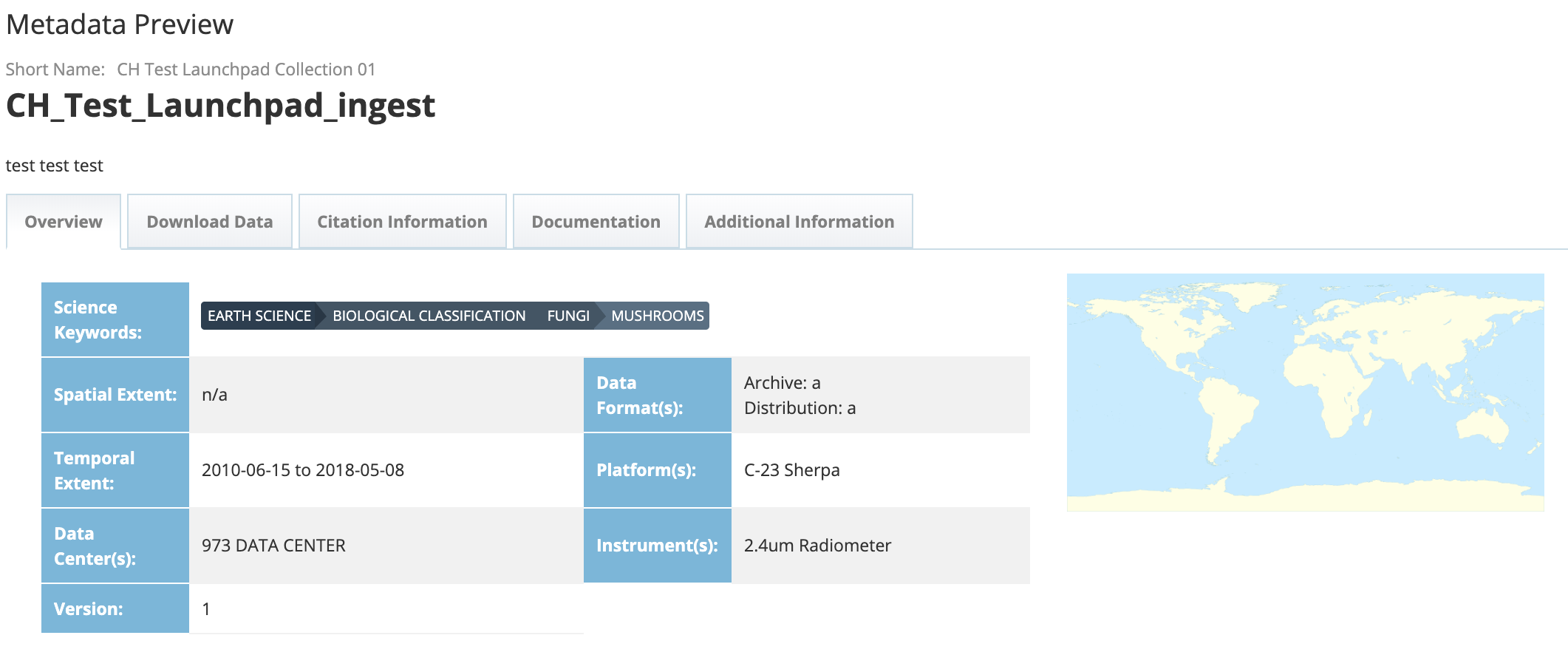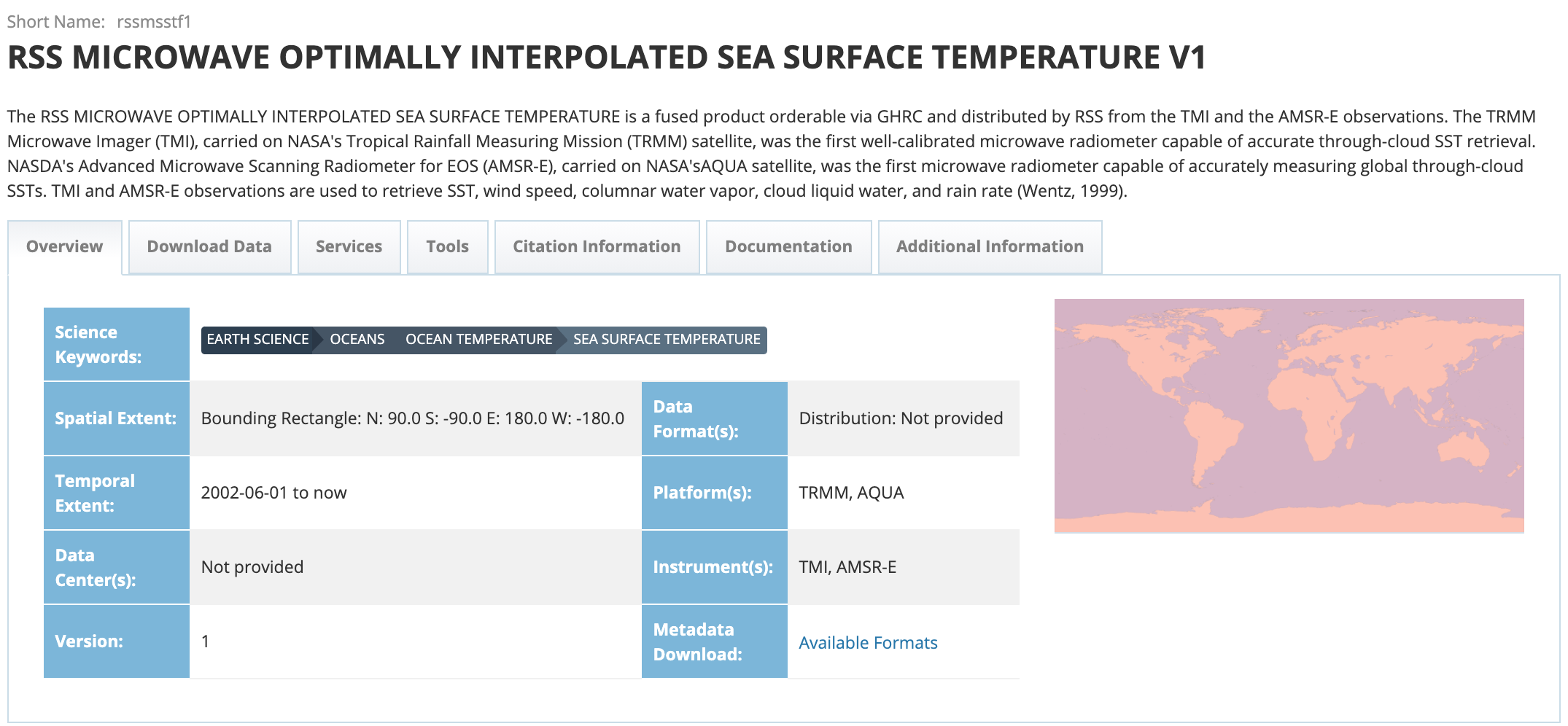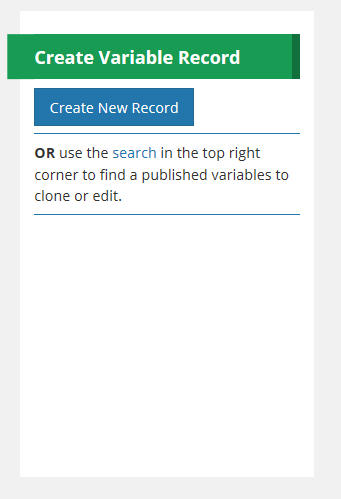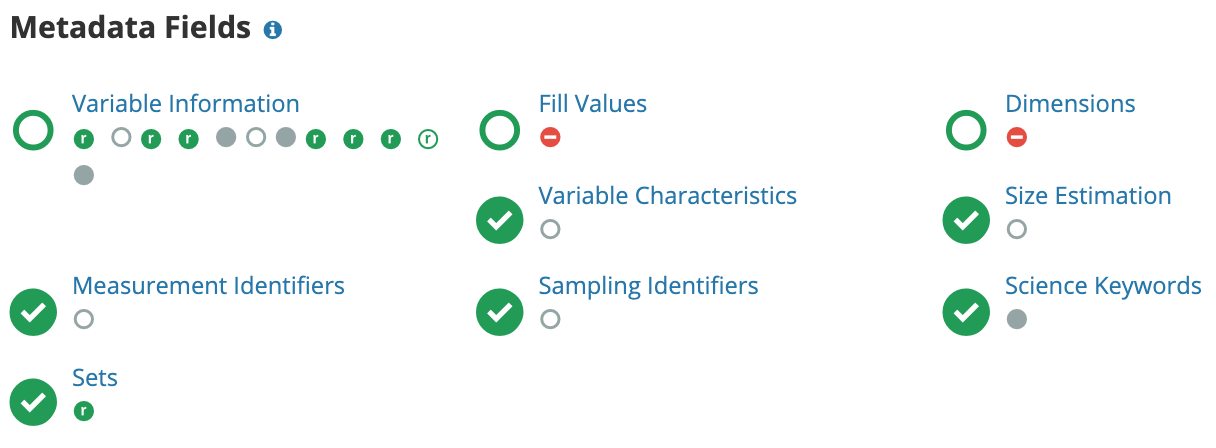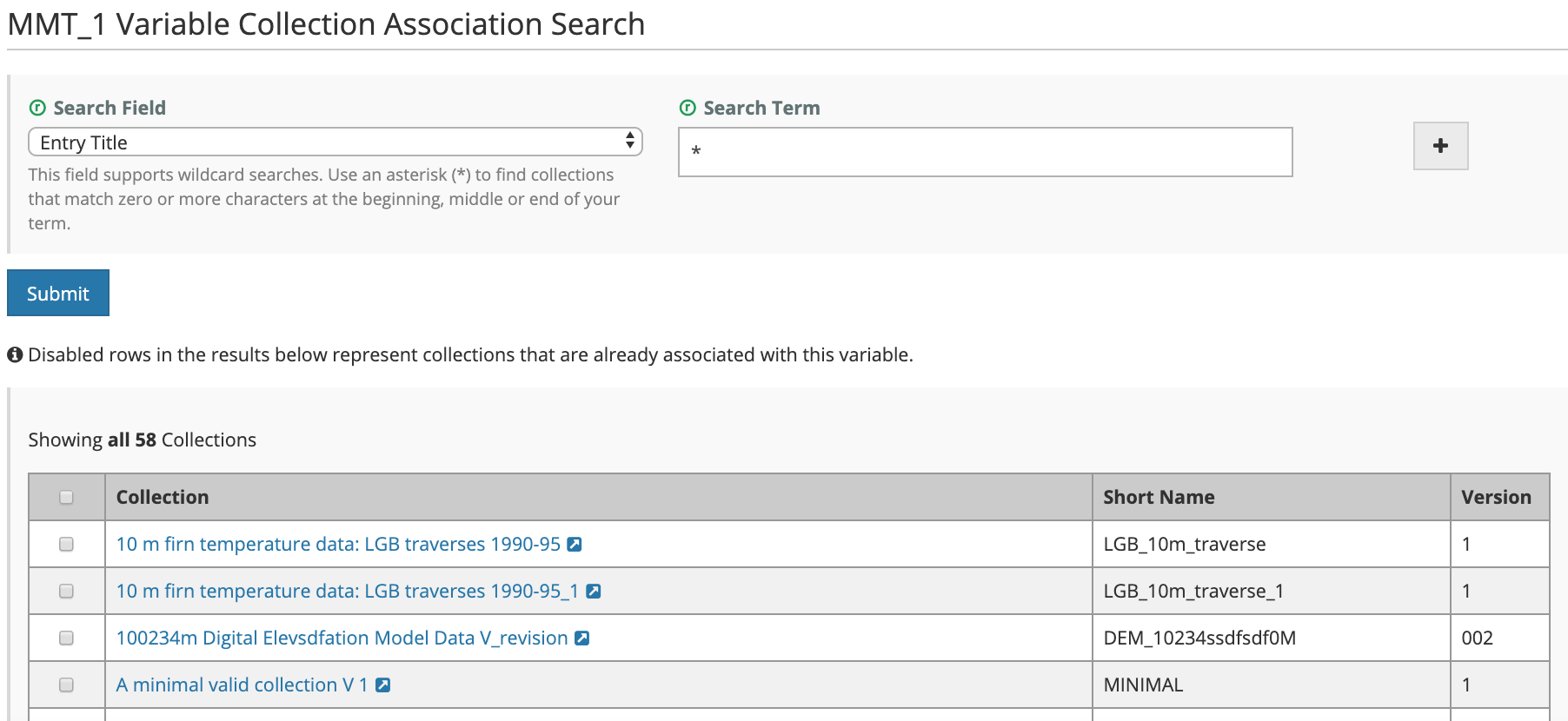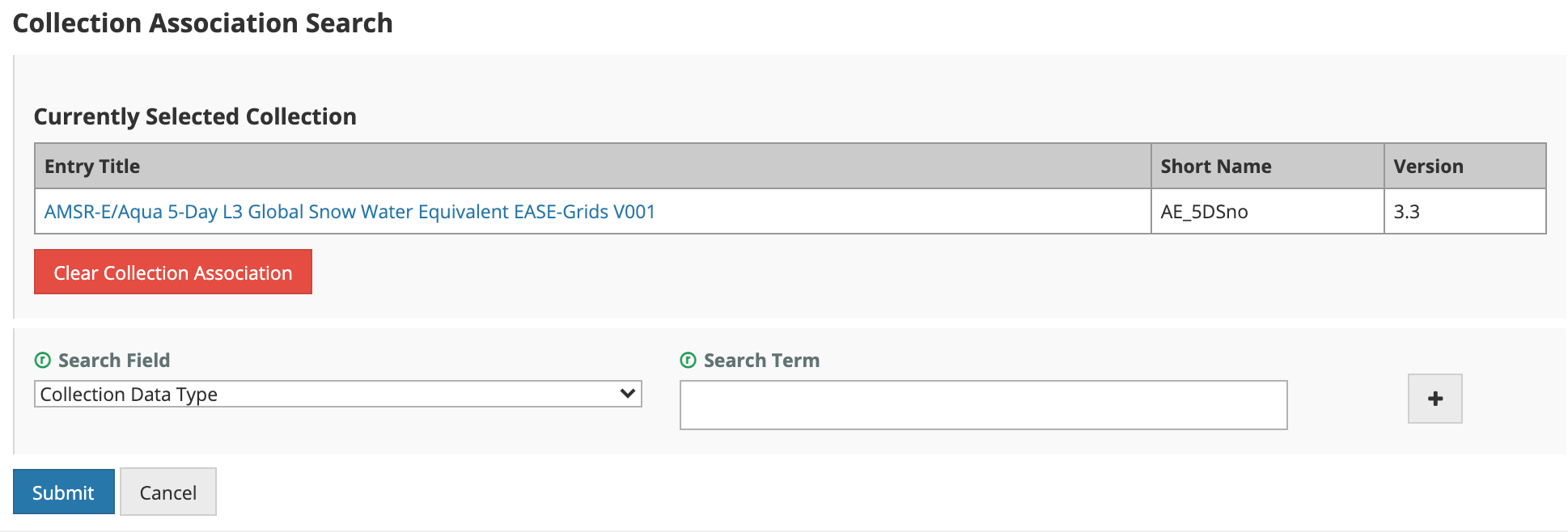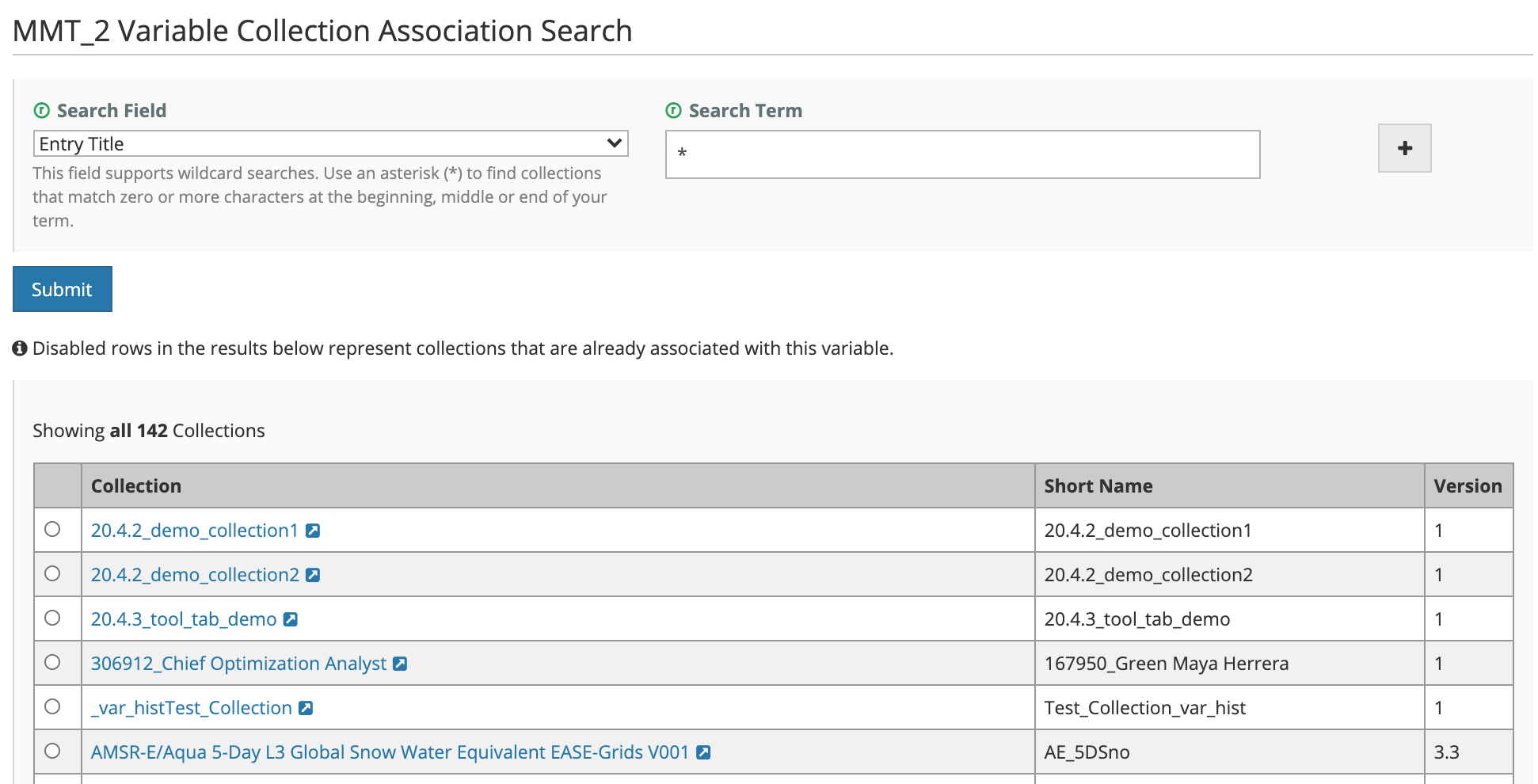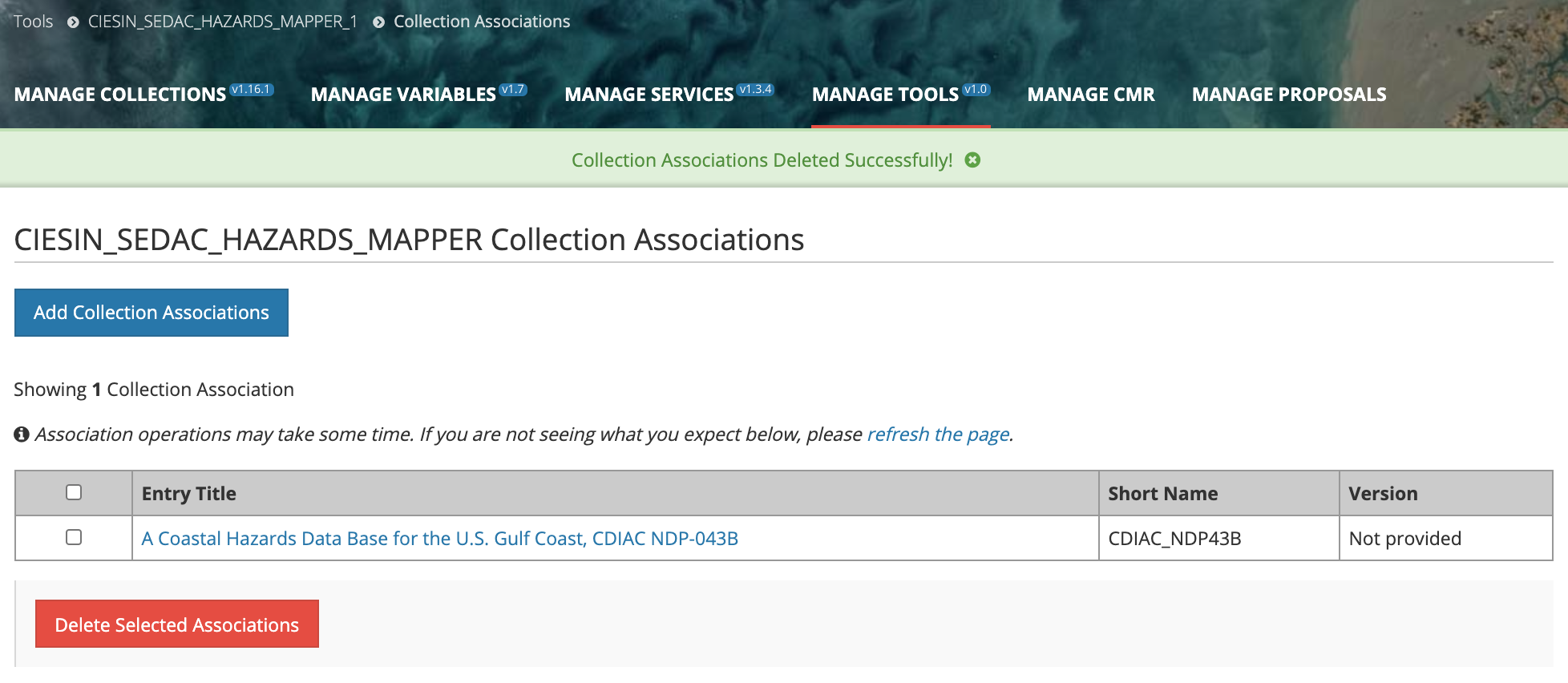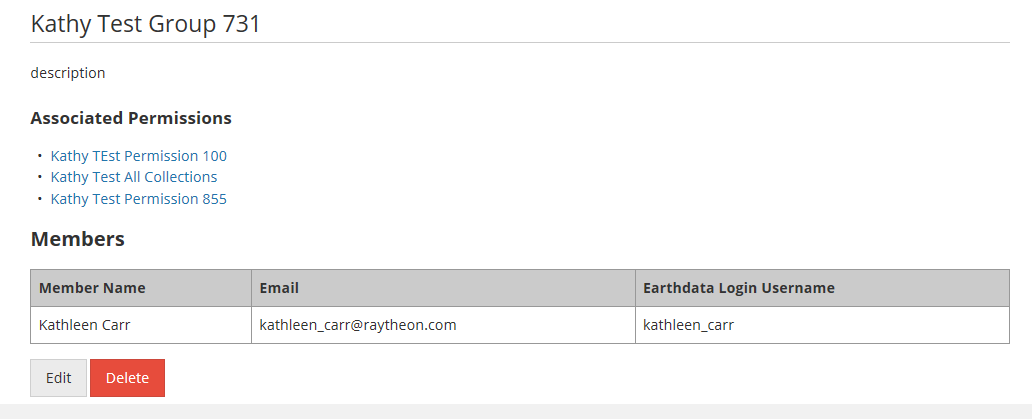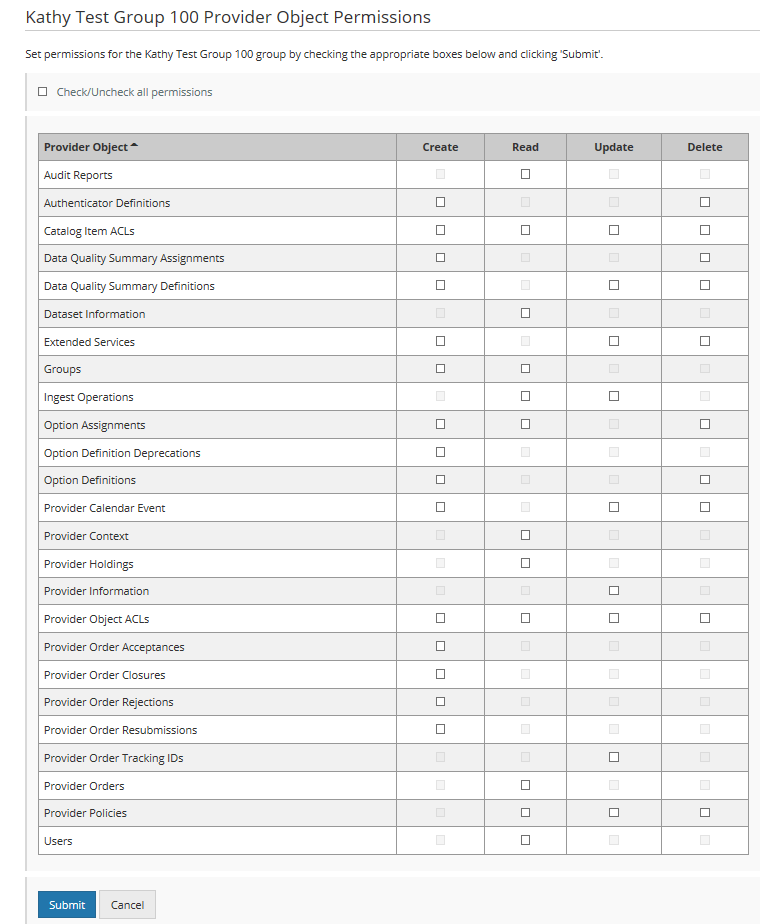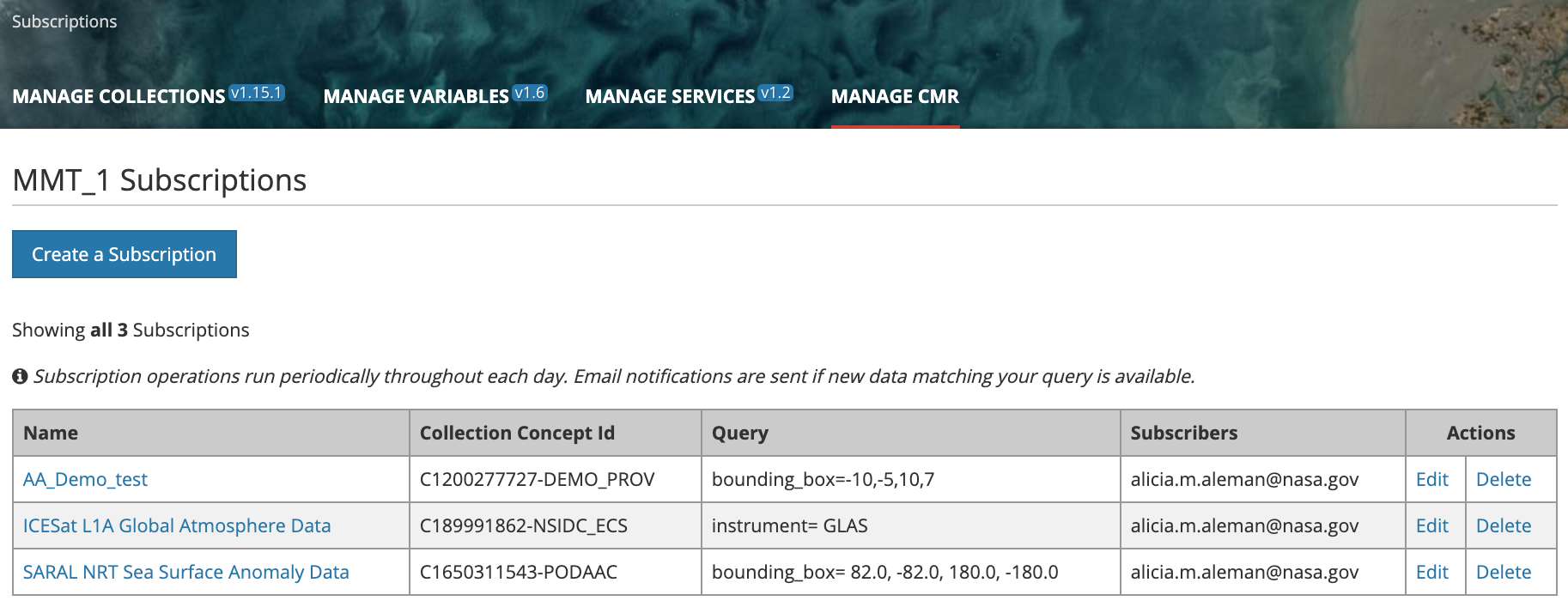Page History
...
To use the MMT, you must have a CMR metadata provider context. Ensure that, for each of your providers, your Earthdata Login username for the appropriate environment (SIT, UAT, PROD) is a member of a group (normally the Administrator group for the provider) that has both 'Provider Context' and 'Provider Object ACLs' permissions. See Manage 'Provider Object Permissions' for a user group.
If you log in login to the MMT but have no provider context set, you will see the following page:
...
Login to the MMT
Click on 'Earthdata Login with Launchpad', and log in login to the MMT using your Earthdata Login username and password Launchpad credentials for the appropriate environment (SIT, UAT, PROD)
Change Provider
...
6. View an HTML rendering of your collection record on the 'preview panel':
7. Special NOTES when creating or editing a collection level record:
...
2. On the Overview tab of the collection information page, click on Metadata Download: 'Available Formats'.
3. You will see a pop-up window asking you to choose the format in which you would like to download the collection metadata.
4. Click on the format that you would like. Your browser and local machine will now prompt you through the download process.
...
6. View an HTML rendering of your collection record template on the 'preview panel':
7. Special NOTES when creating or editing a collection level record template:
...
click on 'Create New Record'. A draft variable record will be created.
NOTE: Before a variable record can be published to the CMR, it must be associated with a published collection record. The collection association can be made before creating a new draft variable record by entering the collection Concept ID (if known) into the provided field OR the collection association can be made when completing the metadata forms (see below).
2. Begin filling in metadata fields for your draft variable record. Use the information icons (blue 'i') to get information about what fields mean and how to format their values.
...
5. Follow progress of your draft record on the progress panel:
The icons on the progress panel have the following meanings:
...
7. When all Required fields are complete with no validation errors (red icon) showing on the progress panel, and the variable record has been associated to a collection, you are ready to Publish your record to the CMR. Click on the 'Publish Variable Draft' button above the Progress Panel on the draft record page:
...
NOTE: A prompt to enter a new Name and Long Name for the clone appears in the blue bar, and the progress panel indicates that the Name and Long Name have not yet been filled in.
4. On the progress panel, click on any section to begin editing the draft record (the clone). You must enter a new Name and Long Name for the clone. Use the progress panel and navigation buttons described above (Create a variable record in the CMR for my provider) to update the metadata in the draft record.
...
Associate a Variable with a Collection for my provider
- Find the variable record using the instructions above (Find and view variable records in the CMR), and click on the Name of the variable in the search results table to view the variable display page.
At the top of the variable display page, click on 'Manage Collection Associations'.
3. A variable can only 1. Before a variable record can be published to the CMR, it must be associated with a single published collection . To add a new collection association, click on the 'Add Collection Associations' button.
If a collection is already associated with this variable, it will be displayed in the table.
record. The collection association can be made before creating a new draft variable record by entering the collection Concept ID (if known) into the provided field
2. If the collection Concept ID is unknown, the collection association can be made by on the 'Collection Association' metadata form
4. A Collection Association Search page will be displayed. Choose a Search Field from the pull-down selections, and enter a Search Term (value) for that Search Field. Note that wildcard searches are supported for some search fields. (The text below the search field will tell you if wildcard searches are supported for that field.)
A variable can only be associated with a single collection. If a collection is already associated with this variable, it will be displayed in the table.
6. A table of collections matching the collection search criteria will be 6. A table of collections matching the collection search criteria will be displayed. Click on the checkbox beside the collection that you wish to associate with the variable, and click on Submit below the collection search results table. The selected collection will be associated with the variable.
7. A Collection Associations results page will be displayed, showing the collection now associated with the Variable.
NOTE: Because the collection / variable association operation is asynchronous, the results page may be displayed before all association has completed. You may need to click on the 'refresh the page' link to see the final results of the collection association.
...
Update a Variable
...
- Collection Association for my provider
- Find the variable record using the instructions above (Find and view variable records in the CMR), and click on the Name of the variable in the search results table to view the variable display page.
At the top of the variable display page, click on 'Manage Collection Associations;
On the Collection Associations page, the collection already associated with this variable will be displayed:
Click the checkbox beside the collection whose association to this variable you wish to delete.
- Click on 'Delete Selected AssociationsUpdate Collection Association'. A Collection Association results Search page will be displayed, showing no collection is associated with the variable.
NOTE: Because the collection / variable disassociation operation is asynchronous, the results page may be displayed before all disassociations have completed. You may need to click on the 'refresh the page' link to see the final results of the collection disassociation.
Manage Service Metadata for my provider
Required Permissions
To create, update, or delete service metadata records in the CMR, or to associate / disassociate services with collections, your login user id must be a member of a group with Provider Object Permissions which include Ingest Operations Read and Update.
- Choose a Search Field from the pull-down selections, and enter a Search Term (value) for that Search Field. Note that wildcard searches are supported for some search fields. (The text below the search field will tell you if wildcard searches are supported for that field.)
5. A table of collections matching the collection search criteria will be displayed. Click on the checkbox beside the collection that you wish to associate with the variable, and click on Submit below the collection search results table. The selected collection will be associated with the variable.
6. A Collection Associations results page will be displayed, showing the collection association has been updated.
NOTE: Because the collection / variable association operation is asynchronous, the results page may be displayed before all association has completed. You may need to click on the 'refresh the page' link to see the final results of the collection association.
Manage Service Metadata for my provider
Required Permissions
To create, update, or delete service metadata records in the CMR, or to associate / disassociate services with collections, your login user id must be a member of a group with Provider Object Permissions which include Ingest Operations Read and Update.
See See your provider Administrator if you are not sure whether your user id has the correct permissions for these operations. The provider Administrator should refer to the "Manage 'Provider Object Permissions' for a user group" section below to assign these permissions.
...
Delete a tool record in the CMR for my provider
- Find the tool record using the instructions above (Find and View Tool in the CMR), and click on the Name of the tool to view the tool page.
- At the top of the tool page, click on 'Delete Tool Record'
3. You will see a pop-up message asking you to confirm the tool record deletion.
4. Click on Yes to delete the tool record. The MMT will then display a 'Tool Deleted Successfully!' message.
Revert to a previous revision of a tool record in the CMR for my provider
...
- using the instructions above (Find and View Tool in the CMR), and click on the Name of the tool to view the tool page.
- At the top of the tool page, click on 'Delete Tool Record'
3. You will see a pop-up message asking you to confirm the tool record deletion.
4. Click on Yes to delete the tool record. The MMT will then display a 'Tool Deleted Successfully!' message.
Revert to a previous revision of a tool record in the CMR for my provider
1. Find the tool record using the instructions above (Find and View Tool in the CMR), and click on the Name of the tool to view the tool page.
2. At the top of the tool page, click on 'Revisions (<number of revisions>)'
3. A table of the (up to) 10 most recent revisions of the tool record will be displayed.
4. You may View previous revisions of the record by clicking on the 'View' link next to the Revision Description. After you determine which revision you want to revert to, click on 'Revert to this Revision' in the Actions column for that revision. You will see a pop-up message asking you to confirm the action:
5. Click on Yes to revert to the selected previous revision of the record. The MMT will then display a 'Revision Created Successfully!' message, as well as the new revision history for the record.
If there were no revisions before you reverted to a previous revision, there will now be n+1 revisions, and the n+1st revision will be identical to the previous revision to which you reverted.
Associate a Tool with one or more Collections for my provider
- Find the tool record using the instructions above (Find and view tool records in the CMR), and click on the Name of the tool in the search results table to view the tool display page.
At the top of the tool display page, click on 'Manage Collection Associations'.
3. On the Collection Associations page, all collections already associated with this tool will be displayed in a table:
4. To add new collection associations, click on the 'Add Collection Associations' button.
5. A Collection Association Search page will be displayed. Choose a Search Field from the pull-down selections, and enter a Search Term (value) for that Search Field. Note that wildcard searches are supported for some search fields. (The text below the search field will tell you if wildcard searches are supported for that field.)
6. A table of collections matching the collection search criteria will be displayed. Any collections in the search results that are already associated with the tool will be present in the table but grayed out. Click on the checkbox beside each collection that you wish to associate with the tool (or click the checkbox in the table header to select all collections in the table), and click on Submit below the collection search results table. All selected collections will be associated with the tool.
7. A Collection Associations results page will be displayed, showing all collections now associated with the tool. This includes any prior associations plus the associations just completed.
NOTE: Because the collection / tool association operation is asynchronous, the results page may be displayed before all associations have completed. You may need to click on the 'refresh the page' link to see the final results of the collection association.
Disassociate a Tool with one or more Collections for my provider
- Find the tool record using the instructions above (Find and
...
- view tool records in the CMR), and click on the Name of the tool
...
- in the search results table to view the tool display page.
...
At the top of the tool
...
3. A table of the (up to) 10 most recent revisions of the tool record will be displayed.
...
display page, click on '
...
Manage Collection Associations';
On the Collection Associations page, all collections already associated with this tool will be displayed in a table:
- Click the checkbox beside each collection whose association to this tool you wish to delete (or click the checkbox at the top of the table to select all collections in the table).
- Click on 'Delete Selected Associations'.
- A Collection Association results page will be displayed, showing all collections still associated with the tool.
NOTE: Because the collection / tool disassociation operation is asynchronous, the results page may be displayed before all disassociations have completed. You may need to click on the 'refresh the page' link to see the final results of the collection disassociation.
5. Click on Yes to revert to the selected previous revision of the record. The MMT will then display a 'Revision Created Successfully!' message, as well as the new revision history for the record.
If there were no revisions before you reverted to a previous revision, there will now be n+1 revisions, and the n+1st revision will be identical to the previous revision to which you reverted.
Produce a Holdings Report for my provider
...
2. A table of groups that you are permitted to see will be displayed. You may filter that table by Provider
Current / Available Providers and/or by User (group member)
Click on 'Apply Filters' to filter the table.
...
4. The Group information page will be displayed. The page shows the group name, group description, all Collection Permissions associated with the group (see next section of this User's Guide for a discussion of Collection Permissions), a link to the Provider Object Permissions associated with the group, and a table of group members.
5. You may Edit or Delete the group from the group display page using the Edit or Delete buttons at the bottom of the page,
...
- On the 'Manage CMR' dashboard, under 'Permissions & Groups', click on 'Groups'
2. A A table of groups that you are permitted to see will be displayed. You may filter that table by Provider
Current / Available Providers and/or by User (group member)
Click on 'Apply Filters' to filter the table.
3. From the resulting table of groups, select the group you wish to update by clicking on the 'Edit' Action in the row with the group name, OR you may click on the Group Name itself and use the Edit button on the group display page described in the previous section.
...
- On the 'Manage CMR' dashboard, under 'Permissions & Groups', click on 'Groups'
2. A A table of groups that you are permitted to see will be displayed. You may filter that table by Provider
Current / Available Providers and/or by User (group member)
Click on 'Apply Filters' to filter the table.
...
4. Click on the Submit button at the bottom of the Edit page to save the changes to the Collection Permission.
Manage 'Provider Object Permissions' for a user group
NOTE: You must have Administrator privileges for your provider to perform this operation.
...
3. Click on the Name of a group in the table to edit the Provider Object Permissions for that group. A table of Provider Objects for that group, with Create, Read, Update, and Delete permissions, will be displayed. Check all appropriate boxes in the table and then click the 'Submit' button at the bottom of the page to save the changes.
Manage 'System Object Permissions' for a user group
NOTE: You must have System Administrator privileges to perform this operation.
...
3. The MMT will display the Subscription display page, with a green banner indicating that the Subscription was created successfully (or a pink banner indicating a failure creating the Subscription).
Update a Subscription
...
2. The MMT will display a table of Subscriptions for your provider.
3. Select the Subscription you wish to update and click on the Edit action for that Subscription. (or you may click on the Name of the Subscription, and then click on the Edit button on the display page for that Subscription).
...
2. The MMT will display a table of Subscriptions for your provider.
3. Select the Subscription you wish to update and click on the Delete action for that Subscription. (or you may click on the Name of the Subscription, and then click on the Delete button on the display page for that Subscription).
...
2. The MMT will display a table of Subscriptions for your provider.
Report problems or get help with MMT
...

